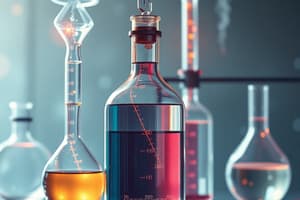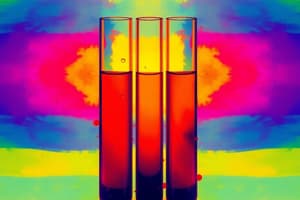Podcast
Questions and Answers
Which of the following gases can be collected using displacement of water?
Which of the following gases can be collected using displacement of water?
- Gases that are soluble in water
- Gases that have a different density than air
- Gases that are slightly soluble in water (correct)
- Gases that have the same density as air (correct)
A gas syringe can only be used to collect gases with high density.
A gas syringe can only be used to collect gases with high density.
False (B)
What is the principle of magnetic attraction in separating mixtures?
What is the principle of magnetic attraction in separating mixtures?
Using a magnet to attract magnetic substances while leaving behind non-magnetic materials.
The process of ____ involves boiling and then condensation.
The process of ____ involves boiling and then condensation.
What can indicate a pure substance when analyzing a chromatogram?
What can indicate a pure substance when analyzing a chromatogram?
Which method can be used to separate a solid-liquid mixture?
Which method can be used to separate a solid-liquid mixture?
What is a chromatogram?
What is a chromatogram?
A ____ is a substance that dissolves in a solvent.
A ____ is a substance that dissolves in a solvent.
What is the purpose of adding boiling chips in simple distillation?
What is the purpose of adding boiling chips in simple distillation?
What happens to a heat-stable soluble solid during evaporation to dryness?
What happens to a heat-stable soluble solid during evaporation to dryness?
Flashcards are hidden until you start studying
Study Notes
Displacement of Water
- Used to collect gases that are similar in density to air and are insoluble or slightly soluble in water.
- Gas syringes are versatile, capable of collecting gases of various densities from chemical reactions.
Methods of Separation
- Physical methods separate mixtures without chemical reactions to yield pure substances.
Separation Techniques for Mixtures
- Solid-Solid: Techniques include magnetic attraction, sieving, and using suitable solvents.
- Solid-Liquid: Techniques involve filtration, evaporation to dryness, and crystallisation.
- Liquid-Liquid: Methods include simple distillation and fractional distillation.
Chromatography
- Solvent acts as the mobile phase; chromatography paper serves as the stationary phase.
- Results on chromatography paper called chromatogram:
- Number of spots indicates the quantity of substances in the sample.
- Horizontally aligned spots signify identical substances.
- A single spot implies a pure substance; multiple spots indicate a mixture.
- Matching spots horizontally suggests a possible sample source.
Examples in Chromatography
- Sample P contains three substances; Q and S contain two substances each; R is a pure substance.
- Matched spots (a and g; b and h) identify similarities in substances.
- R is confirmed as a pure sample, while P, Q, and S are mixtures.
Separating Solid-Solid Mixtures
- Magnetic Attraction: Utilizes magnets to extract magnetic substances (e.g., iron filings from sulfur).
- Sieving: Relies on particle size; smaller particles pass through sieves, leaving larger particles behind (e.g., fine sugar from coarse salt).
- Using Suitable Solvent: Dissolves one component while leaving others insoluble (e.g., salt in water, no effect on sand).
Separating Solid-Liquid Mixtures
- Simple Distillation: Two state changes, boiling (liquid to gas) followed by condensation (gas to liquid).
- Filtration:
- Residue: Insoluble solid on filter paper.
- Filtrate: Solution collected post-filtration.
Evaporation to Dryness
- Designed to obtain heat-stable soluble solids (e.g., sodium chloride).
- Converts NaCl in solution to dry NaCl upon heating.
Crystallisation
- Suitable for heat-sensitive soluble solids (e.g., copper(II) chloride).
- Heating causes saturation, followed by cooling for solid crystallisation.
Simple Distillation Setup
- Thermometer's bulb positioned near the condenser to measure vapor boiling point accurately.
- Boiling chips prevent bumping during boiling.
- A conical flask ensures minimal loss of distillate.
- Water flows counter-current to vapor flow to maintain cold surfaces for effective condensation.
Key Distillation Facts
- Constant temperature during distillation until the entire substance is vaporized.
- Condensed vapor collects in the receiving flask as distillate.
Studying That Suits You
Use AI to generate personalized quizzes and flashcards to suit your learning preferences.




